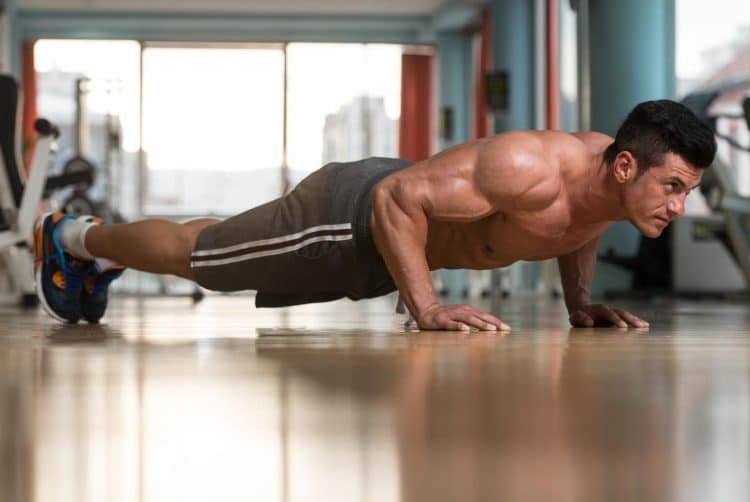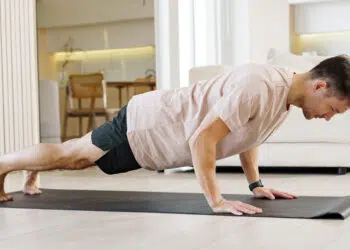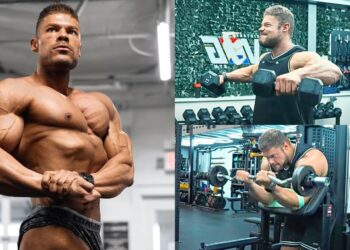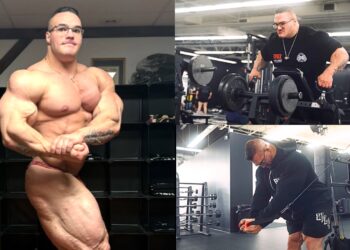Build your chest, back, shoulders, and arms with the best bodyweight upper-body exercises for all levels.
When any of my clients or acquaintances tell me that they don’t have time to train, I say two words to them, “bodyweight exercises.”
Bodyweight exercises are the ultimate excuse-free workout. It doesn’t matter where you are or what time of day it is; you can always crank out some push-ups, air squats, pull-ups, or leg lifts.
Bodyweight exercises were the first type of strength training I ever did. And now, almost 40 years later, I’m still a massive fan. I build most of my workouts around bodyweight training and often prescribe it to my personal training clients.
Some people are concerned that bodyweight exercises aren’t as effective as lifting weights, but such worries are unfounded. In a study published on PubMed, researchers found that bodyweight push-ups and bench presses produced similar strength and hypertrophy gains (1). This result mirrors the findings of several other studies, also on PubMed (2, 3).
Does this mean that bodyweight exercises are better than conventional strength training? Probably not. Lifting weights offers many benefits that you can’t get from bodyweight exercises. Read more Calisthenics vs. Weightlifting and which is best?
Level Up Your Fitness: Join our 💪 strong community in Fitness Volt Newsletter. Get daily inspiration, expert-backed workouts, nutrition tips, the latest in strength sports, and the support you need to reach your goals. Subscribe for free!
However, remember that perfection is the enemy of good. Any workout done consistently will always produce better results than the best workout performed infrequently. Compared to not training at all, bodyweight exercises will always be a winner!
In this article, I reveal the best upper body bodyweight exercises for beginner, intermediate, and advanced-level exercisers. Use these exercises for an excuse-free upper body workout you can do anywhere and anytime.
Bodyweight Exercise Basics
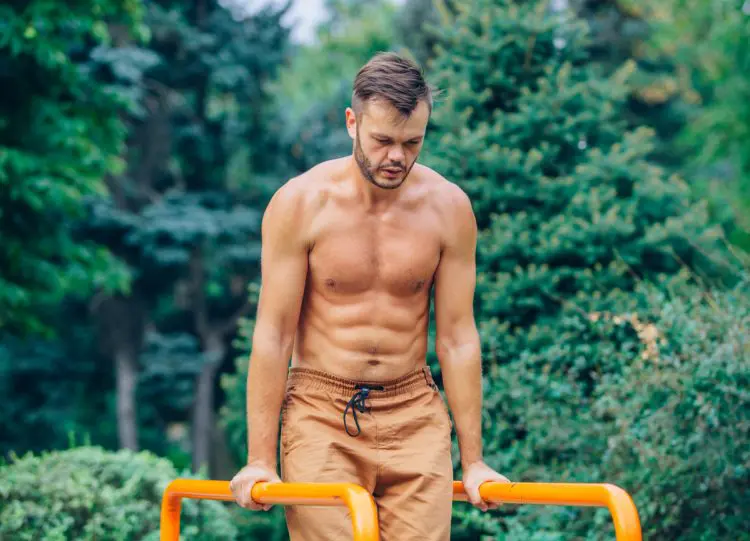
Before I reveal the best upper body bodyweight exercises, let’s take a brief look at the ins and outs of this type of training.
What is Body Weight Training?
Firstly, bodyweight training is also known as calisthenics. We get calisthenics from the Greek words for beauty and strength. I don’t know about you, but I find the idea of building beautiful strength very appealing!
Anyway, bodyweight exercises use your body for resistance. With this type of training, you are the barbell, bench, and machine. As such, the overload on your muscles depends on what you weigh.
However, the position of your limbs, hand placement, angle of your body, etc., determine how much of your body weight you have to lift. As such, most bodyweight exercises are adaptable to different strength levels.
It’s also possible to modify exercise difficulty by using resistance bands and weighted vests. Although, that starts to make what should be a simple and natural form of training more complicated. Therefore, I’ll be steering away from the use of extraneous equipment.
That said, you will need access to pull-up/chin-up bars, dipping bars, and a few other items for some of the exercises. Otherwise, it’s just you and the floor, which will be very limiting.
Bodyweight Exercise Advantages and Benefits
Not sold on the idea of bodyweight-only training? I hear you! Consider these benefits before writing off calisthenics for good.
Low-Cost: Bodyweight exercises can be cheap or even free to perform. Many cities have public calisthenic parks. You can buy things like pull-up bars and parallettes very cheaply or make them yourself. Compared to equipment-based strength training, bodyweight exercises are very low-cost.
Convenience: As I wrote in the intro, bodyweight exercises are the ultimate excuse-free workout. All you need is your body (check!), some floor space (check!), and some get-up-and-go (check!). Because you don’t need to go to a gym and can train almost anywhere and anytime. Consequently, working out has never been so convenient.
It’ll be helpful if you have somewhere to hang for pull-ups, chin-ups, etc. But, in a pinch, you can make do with a tree branch or roof joist. With so few barriers to overcome, you have no valid excuse for missing workouts.
Safety: Bodyweight exercises are incredibly safe. With no weights to drop, you can train to failure without fear of getting pinned under a heavy barbell. Similarly, the movements themselves tend to be very natural and joint-friendly. Strength training is already a relatively safe activity, but bodyweight exercises take the risk down to almost zero.
Highly Functional: A functional exercise mirrors the demands of everyday or sporting activities. I’d argue that nothing is more functional than being able to lift and control your body. Forget balancing on a stability ball doing curls. That’s not functional. However, exercises like push-ups, dips, and pull-ups are.
Versatility: You can use bodyweight exercises to train for most fitness goals, including strength, hypertrophy, endurance, athleticism, fat loss, improved sports performance, cardiovascular fitness, and general health. It all depends on how you do your chosen exercises and how you program them.
Easy to Progress and Regress: Making a bodyweight exercise harder or easier is as simple as moving your hands or feet. In most cases, you can make these adjustments instantly. There are also endless ways to perform many bodyweight exercises, so you’ll never outgrow this type of training.
For example, for push-ups, you could progress like this:
- Incline push-ups (hands on a wall)
- Incline push-ups (hands on a bench)
- Kneeling push-ups
- Regular push-ups
- Wide grip push-ups
- Diamond push-ups
- Deficit push-ups
- Decline push-ups (feet on a bench)
- Weighted push-ups
- Gymnastic ring push-ups
- Plyometric push-ups
- Archer push-ups
- Pseudo planche push-ups
- One-arm push-ups
- Handstand push-ups
- Planche push-ups
These are enough variations to keep you progressing for years, if not decades.
In summary, the advantages and benefits of bodyweight exercises include:
- Low cost
- Convenience
- Safety
- Functionality
- Versatility
- Easy progression/regression
The Best Upper Body Bodyweight Exercises
Bench presses, lat pulldowns, and shoulder presses are popular strength training exercises. However, they aren’t the only way to develop the upper body of your dreams.
Here are what, after 30+ years of training experience, are my pick of the best upper body bodyweight exercises. For ease, I’ve listed them in approximate order of difficulty, from beginner to advanced.
1. Push-Ups
Target muscles: Pectoralis major, deltoids, triceps, core.
If squats are the king of leg exercises, push-ups should hold the same title for the upper body. The push-up might be a commonplace, somewhat humble exercise, but it’s also one of the best chest and triceps builders around. Needless to say, no list of the best upper body bodyweight exercises is complete without push-ups!
Steps:
- Squat down and place your hands flat on the floor, fingers pointing forward and roughly shoulder-width apart.
- Brace your core, pull your shoulders down and back, and walk your feet out so your legs and body are straight.
- Bend your arms and lower your chest down to within an inch of the floor. Do not lead with your head. Tuck your elbows in as you descend.
- Drive your hands into the floor and push yourself back up so your arms are straight.
- That’s one rep – keep going!
Tips:
- Bend your legs and rest on your knees to make push-ups easier.
- Raise your feet to put more weight on your arms and make this exercise harder.
- Try a wider grip to emphasize your chest, or a closer grip to work your triceps more.
2. Deficit Push-Ups
Target muscles: Pectoralis major, deltoids, triceps, core.
One of the most straightforward ways to make push-ups more challenging and chest-centric is to increase your range of motion. Longer reps mean more work for the target muscles. The easiest way to do this is by raising your hands, which turns regular push-ups into deficit push-ups. Take care, though, as this variation can be hard on the shoulders. Skip it if you have shoulder pain.
Level Up Your Fitness: Join our 💪 strong community in Fitness Volt Newsletter. Get daily inspiration, expert-backed workouts, nutrition tips, the latest in strength sports, and the support you need to reach your goals. Subscribe for free!
Steps:
- Place two raised platforms on the floor, roughly shoulder-width apart. You can use push-up handles, dumbbells, bricks, weight plates, yoga blocks, or anything that’s roughly 4 to 6 inches high.
- Squat down and place your hands on your platforms. Brace your core, pull your shoulders down and back, and walk your feet out so your legs and body are straight.
- Bend your arms and lower your chest down between your hands. Get a good stretch in your pecs. Do not lead with your head. Tuck your elbows in as you descend.
- Drive your hands into the floor and push yourself back up so your arms are straight.
Tips:
- Make this exercise easier by bending your legs and resting on your knees, or harder by putting your feet on a chair or bench.
- Keep your core tight throughout. Do not allow your hips to lift or fall out of alignment.
- Widen your hands to emphasize your chest, or bring them closer together to work your triceps more.
3. Dips
Target muscles: Pectoralis major, deltoids, triceps, core.
Bodybuilders call dips the upper body squat. That’s because they’re an incredibly powerful exercise for building upper body strength and mass. If push-ups are no longer challenging, and you want to take your upper body workout to the next level, it’s time to graduate to dips. However, like deficit push-ups, this exercise can be hard on your shoulder joints.
Steps:
- Grip the parallel bars with your hands slightly wider than shoulder-width apart.
- Support your weight on straight arms. Pull your shoulders down and back, and brace your core.
- Cross your feet if you wish.
- Bend your arms and descend until your elbows hit at least 90 degrees.
- Push back up until your arms are straight, and repeat.
Tips:
- Lean forward to increase chest engagement, or keep your torso upright to work your triceps more.
- Keep your feet on the floor and use your legs for assistance if necessary.
- You can also do bench dips, which are suitable for beginners, like this:
4. Pike Push-Ups
Target muscles: Deltoids, triceps, core.
Calisthenic training often involves adopting unusual body positions to target the muscles you want to train. With pike push-ups, you’re going to invert your body to replicate overhead presses. While this might not be very comfortable, I guarantee it’ll challenge your shoulders and triceps, boosting your upper body gains.
Steps:
- Adopt the push-up position with your hands shoulder-width apart and core braced.
- Keeping your legs straight, lift your hips into the air and walk your hands back toward your feet so your body forms an inverted V shape.
- Bend your arms and lower your forehead to the floor.
- Extend your arms and repeat.
Tips:
- The closer your hands are to your feet, the more demanding this exercise becomes.
- Place your hands on blocks or push-up handles to increase your range of motion.
- Raise your feet to put more weight on your arms, like this:
5. Handstand Push-Ups
Target muscles: Deltoids, triceps, core.
Doing push-ups with your feet on the floor means you’re only ever lifting a percentage of your body weight. That all changes with handstand push-ups. Being fully inverted means you’ll have to lift your entire body weight with just your arms, and your pecs won’t be able to provide much force, so it’s all about your deltoids. As such, this is a killer shoulder and triceps builder, and ideal for advanced exercisers.
Steps:
- Stand in front of a smooth wall. Place your hands on the floor about 12 inches from the wall, fingers shoulder-width apart.
- Kick up and into a handstand so your feet rest against the wall.
- Bend your arms and lower your head to lightly touch the floor.
- Extend your arms and shoulders and push yourself back up.
- Continue for the desired number of reps.
Tips:
- Use a smooth wall and remove your shoes to minimize friction and avoid making this exercise harder than necessary.
- Place your hands on handles/blocks to increase your range of motion.
- If you cannot push yourself up, focus on doing negatives until you can. Kick up into a handstand, slowly lower your head to the floor, and put your feet down. Get back into the handstand position and repeat.
6. Inverted Rows
Target muscles: Latissimus dorsi, trapezius, rhomboids, deltoids, biceps, forearms.
Inverted rows, also known as body rows and Australian pull-ups, are an excellent upper-back exercise. They work your lats and the muscles between your shoulder blades – the trapezius and rhomboids. These are critical muscles for better posture. As an added benefit, inverted rows also work your glutes and hamstrings, albeit to a lesser degree.
Steps:
- Sit on the floor below a waist-high bar, e.g., a barbell in a squat rack. Hold the bar with an overhand, slightly wider than shoulder-width grip.
- Lean back so your arms are straight, and brace your core. Pull your shoulders down and back.
- Walk your legs out until your legs and body are straight.
- Bend your arms and pull your chest up to the bar.
- Descend under control and repeat.
Tips:
- You can also do this exercise using a suspension trainer or gymnastic rings.
- Switch to an underhand grip to emphasize your biceps.
- Bend your legs and put your feet flat on the floor to make this exercise easier:
7. Pull-Ups/Chin-Ups
Target muscles: Latissimus dorsi, trapezius, rhomboids, deltoids, biceps, forearms.
Pull-ups and chin-ups are variations of the same movement. Regardless of which one you do, you’ll get a great back and biceps workout. These exercises aren’t just effective strength and muscle builders; they’re a powerful reminder to keep your weight under control. Losing fat is one of the best ways to get better at pull-ups and chin-ups.
Steps:
- Hang from an overhead bar using an overhand, slightly wider than shoulder-width grip (pull-ups), or a narrower than shoulder-width underhand grip (chin-ups).
- Pull your shoulders down and back, and brace your core.
- Without kicking or swinging your legs, bend your arms and pull your chin up and over the bar.
- Lower under control and repeat.
Tips:
- Do underhand chin-ups to emphasize your biceps, or overhand pull-ups to work your back slightly more.
- Can’t decide between pull-ups and chin-ups? Check this comparison article to discover which one is best for you.
- Keep your feet on the floor and do seated pike pull-ups/chin-ups if you aren’t strong enough to do pull-ups/chin-ups yet.
8. Front Lever Raises
Target muscles: Latissimus dorsi, trapezius, rhomboids, deltoids, forearms.
Front lever raises are a gymnastics-based exercise for your back and core. Unlike pull-ups and chin-ups, you don’t use your biceps much, so all the work falls to your lats. This is a challenging exercise, but mastering it will help build the strength you need to do full front levers, which are a very advanced bodyweight exercise.
Steps:
- Hang from a pull-up bar with an overhand, shoulder-width grip. Your arms and legs should be straight.
- Brace your core, and pull your shoulders down and back.
- Lean back and simultaneously push your arms forward to raise your legs. Keep your body straight.
- Lift your legs to parallel to the floor or, if you prefer, until you are fully inverted. The inverted version is slightly easier as you get a brief rest between reps.
- Lower your legs smoothly and under control, and repeat.
Tips:
- Imagine you are doing a straight arm pulldown to understand the arm action during this exercise.
- Use gym chalk on your hands to prevent slipping.
- Bend your legs to make this exercise easier, i.e., front tuck lever raises, like this:
9. Muscle-Ups
Target muscles: Latissimus dorsi, biceps, pectoralis major, deltoids, triceps, core.
Muscle-ups combine pull-ups with straight bar dips to work virtually every muscle in your upper body. This exercise requires and develops immense strength and power, and plenty of skill and coordination, too. However, if you can do ten or more perfect pull-ups and dips, you should be able to pick this exercise up pretty quickly.
Steps:
- Hang from a sturdy overhead bar using a shoulder-width grip. Pull your shoulders down and back, and brace your core. Extend your legs very slightly in front of you so your body forms a hollow position.
- Swing your legs backward and then forward again, simultaneously flexing your lats.
- Using this momentum, pull hard with your arms and heave your chest up toward the bar. Try to get your chest above the bar.
- As you feel your weight rise up and over the bar, roll your hands forward and then transition from a pull to a push.
- Lean forward over the bar and extend your arms until your elbows are straight and you are supporting your weight on top of the bar.
- Bend your arms and lower yourself back down to full arm extension.
Tips:
- Drop off the bar between reps to rest and maximize performance. This is especially important when first learning the muscle-up.
- Use a false or thumbless grip to minimize friction and make it easier to switch between pulling and pushing.
- Lower yourself under control; descending too quickly will shock-load your muscles and joints and could cause injury.
Closing Thoughts
Many exercisers and a few fitness experts believe that you can’t build muscle and strength with bodyweight exercises. However, plenty of studies and anecdotal evidence suggest otherwise.
After all, just look at the incredible physiques of some elite male gymnasts. They never train with weights, and yet they look as good, if not better, than many bodybuilders. Gymnasts are also phenomenally strong.
That’s not to say that bodyweight training is better than lifting weights, but it compares very favorably.
So, whether you are a beginner, intermediate, or advanced exerciser, you can build the upper body of your dreams with bodyweight training. Build your workouts around the exercises in this article, and your success is all-but guaranteed!
References:
- Kikuchi N, Nakazato K. Low-load bench press and push-up induce similar muscle hypertrophy and strength gain. J Exerc Sci Fit. 2017 Jun;15(1):37-42. doi: 10.1016/j.jesf.2017.06.003. Epub 2017 Jun 29. PMID: 29541130; PMCID: PMC5812864.
- Kotarsky CJ, Christensen BK, Miller JS, Hackney KJ. Effect of Progressive Calisthenic Push-up Training on Muscle Strength and Thickness. J Strength Cond Res. 2018 Mar;32(3):651-659. doi: 10.1519/JSC.0000000000002345. PMID: 29466268.
- Tillaar RVD. Comparison of Kinematics and Muscle Activation between Push-up and Bench Press. Sports Med Int Open. 2019 Sep 5;3(3):E74-E81. doi: 10.1055/a-1001-2526. PMID: 31508485; PMCID: PMC6728153.

